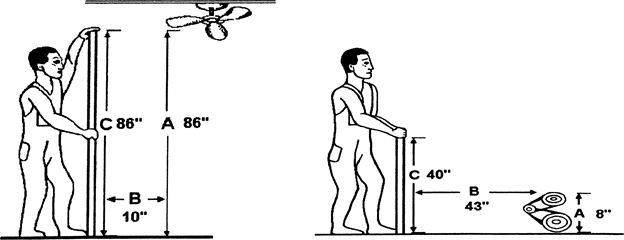PDFWAC 296-806-20056
Make sure safeguarding by distance meets these requirements.
You must make sure means used to safeguard by distance do both of the following:
(1) Prevent parts or material from falling on employees below; and
(2) Separate employees on fixed ladders, stairs, floors, or other walking or working surfaces from the hazard by:
(a) More than seven feet vertically; or
(b) A horizontal distance that prevents employees from contacting or being injured by the hazard according to the distances in Table 200-2.
Table 200-2 helps you identify either the required horizontal distance from the hazard to the barricade (B), or the required height of the barricade (C), as long as you know A and either variable, B or C.
Table 200-2
Safe Distances for Fixed Barricades (B)
Height of the Hazard (A) | Height of the Barricade (C) | |||||||
96 | 86 | 78 | 71 | 63 | 55 | 48 | 40 | |
96 | 0 | 4 | 4 | 4 | 4 | 4 | 4 | 4 |
86 | . . . . | 10 | 14 | 16 | 20 | 20 | 24 | 24 |
78 | . . . . | . . . . | 14 | 20 | 24 | 28 | 36 | 43 |
71 | . . . . | . . . . | . . . . | 24 | 36 | 36 | 40 | 43 |
63 | . . . . | . . . . | . . . . | 20 | 36 | 36 | 40 | 51 |
55 | . . . . | . . . . | . . . . | 4 | 32 | 36 | 40 | 51 |
48 | . . . . | . . . . | . . . . | . . . . | 20 | 36 | 40 | 55 |
40 | . . . . | . . . . | . . . . | . . . . | 12 | 36 | 40 | 55 |
32 | . . . . | . . . . | . . . . | . . . . | . . . . | 24 | 36 | 51 |
24 | . . . . | . . . . | . . . . | . . . . | . . . . | . . . . | 20 | 48 |
16 | . . . . | . . . . | . . . . | . . . . | . . . . | . . . . | 12 | 48 |
8 | . . . . | . . . . | . . . . | . . . . | . . . . | . . . . | 8 | 43 |
Note: | The height and distance requirements of Table 200-2 are designed to safeguard workers from a fixed hazard. If a hazard involves flying chips, fluids, parts or materials, the barrier height, distance, and construction may need to be adjusted to provide adequate protection. |
Illustration 2 - How to measure variables for Table 2
 |
Examples:
(1) If the height of the hazard (A) is seventy-eight inches, and the horizontal distance from the hazard to the barricade (B) is fourteen inches, the required height of the barricade (C) is seventy-eight inches.
(2) If the height of the hazard (A) is eighty-six inches, and the height of the barricade (C) is fifty-five inches, then the required horizontal distance from the hazard to the barricade (B) is twenty inches.